Mystery Animal Contest: Who Is This Wide-Eyed Flufftail?
Guess the species (either common or Linnaean) by tweeting at us--we're @PopSci--and get your name listed right here! Plus eternal glory, obviously. Update: We have a winner!

So, here are the rules: To answer, follow us on Twitter and tweet at us with the hashtag #mysteryanimal. For example:
Hey @PopSci, is the #mysteryanimal a baboon?
And then I might say “if you think that’s a baboon, perhaps you are the baboon!” But probably not, because this is a positive environment and all guesses are welcome and also this is not a very common animal so guess whatever you want!
The first person to get it right wins! We’ll retweet the answer from @PopSci, and also update this post so your amazing animal knowledge will be permanently etched onto the internet. Show your kids! Your dumb kids who thought that was a baboon!
Update: And the winner is…Eve Hardy, who correctly guessed that this is a cacomistle! The cacomistle, native to Central America from southern Mexico down to Panama, is a member of the Procyonidae family, otherwise known as the raccoon family (although it also includes kinkajous, olingos, and coatis). It’s a very solitary creature, requiring a large territory and rarely interacting with other cacomistles. It mostly lives in the forest canopy, is nocturnal, and is an opportunistic eater, much like its raccoon siblings–it’ll eat everything from fruit to insects to bird eggs to lizards.
The name “cacomistle” actually means “half cat” in the Nahuatl language, though the cacomistle is not, in fact, a cat. It’s commonly mistaken for the ringtail (which is also known as a miner’s cat or ring-tailed cat, though it is also not a cat), which more Americans may be familiar with–it can be found throughout the southwestern states, and is in fact the state animal of Arizona. You can tell the cacomistle apart from the ringtail in a few ways; the cacomistle has pointed ears, its claws do not retract, and its tail is comparatively longer than the ringtail’s. In fact, the cacomistle’s tail can often be longer than the cacomistle itself. Hi cacomistle!